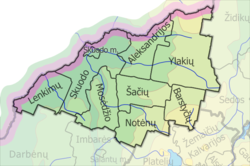This article needs additional citations for verification .(April 2008) |
Skuodas District Municipality Skuodo rajono savivaldybė Skouda rajuona savėvaldībė | |
|---|---|
 Location of Skuodas district municipality within Lithuania | |
 Map of Skuodas district municipality | |
| Coordinates: 56°16′N21°31′E / 56.267°N 21.517°E | |
| Country | |
| Ethnographic region | Samogitia |
| County | |
| Capital | Skuodas |
| Elderships | 9 |
| Area | |
• Total | 911 km2 (352 sq mi) |
| • Rank | 41st |
| Population (2021 [1] ) | |
• Total | 16,250 |
| • Rank | 47th |
| • Density | 17.8/km2 (46.2/sq mi) |
| • Rank | 34-35th |
| Time zone | UTC+2 (EET) |
| • Summer (DST) | UTC+3 (EEST) |
| Telephone code | 440 |
| Major settlements | |
| Website | www |
Skuodas District Municipality is one of 60 municipalities in Lithuania.
It is the only territory whose Council is using the Samogitian language. [2]

